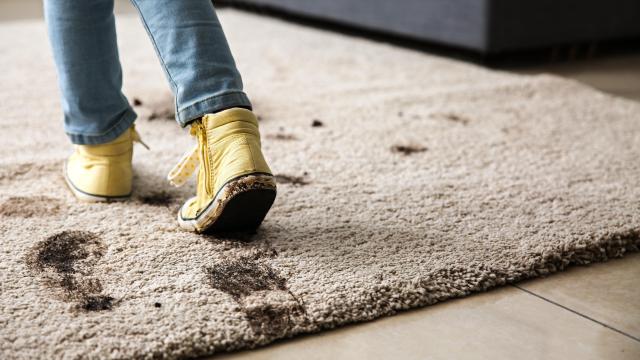April showers bring…mud. Just a lot of mud. A wet day out can leave you with mud on everything from shoes, to hands, to paws, to (eventually) your carpet and furniture. You can’t always prevent the mess from happening — especially if you have kids and/or dogs — but you can clean it up. Here are strategies for getting mud out of basically anything.
Shoes
For tips to get mud off the soles of your shoes, turn to the shoe experts. Nike advises your first step should be to remove any loose bits or big chunks of mud using a soft-bristled brush. Then, use that same brush to apply a paste to the sole made up of three parts baking soda and one part water. Use pressure when scrubbing this mixture into the bottom of the shoe. If the footwear in question has treads or other divots on the bottom, use a small tool — like a paper clip — to push the paste into the tiny spaces.
Next, dilute a few drops of dish soap in a bowl of water and use a brush to scrub any stains on the upper part of the shoes. Take the shoelaces out and submerge them in the soapy water, then massage them with your fingers. Rinse the soap away and blot with a cloth to remove excess water before setting them somewhere warm and sunny to dry, which will take around eight hours. If the shoes seem especially wet you can speed along the process by stuffing them with newspaper to absorb some of the moisture. Avoid the temptation to put them in the dryer, which can damage both your shoes and the machine.
Carpet
Before you can clean muddy carpet, you’ll need to wait until the mud is dry, according to Angi, lest you spread the mess further into the carpet fibres. Once the mud has turned cake-y, scrape as much as you can out of the fibres with a paint scraper or butter knife, then vacuum up the remnants. Next, mix one tablespoon of dish soap with two cups of warm water, apply it to a cloth, and use it to treat the stain — don’t rub hard, just dab gently. Blot with a clean cloth and, if necessary, repeat the process until the mud is all gone. Use another cloth dampened with cold water to take care of lingering soap, and allow to dry.
Clothing
Again, Mulberrys Garment Care recommends waiting until the mud has dried and using a butter knife to scrape off the excess. Next, apply liquid laundry detergent directly to the stain and let it soak in for at least 15 minutes. This is not time off for you, though: You need to continue to rub the fabric against itself every three to five minutes to loosen the stain. For best results, rinse the detergent away and then apply stain remover; let that sit for another three to five minutes. When the time is up, wash the garment as usual, but don’t dry it until you’ve confirmed everything came out, as that can set the stain. If it needs more work, repeat the entire process — detergent, stain remover, and wash cycle.
Furniture
Did the mud make it to your furniture? Don’t panic. If it’s still wet, J&R’s Carpet Cleaning advises you can dab upholstery with a dry cloth to remove the top layer of mud. If it’s dry, once again: scrape it with a butter knife to remove what you can. Now, get your laundry detergent back out and dip a moistened toothbrush into it, then use the wet brush to gently scrub the stain (make sure your detergent is colour safe; if you aren’t sure, test first on an inconspicuous area). Don’t get the fabric too wet, which will only create more mud; you mostly want to scrub away at the stain with the detergent. Let sit for 15 minutes, then return with a mixture of equal parts white vinegar and water. Dip a rag into it, then use it to blot the area, but again, don’t rub. Repeat the steps if necessary, leaving plenty of time for the spot to air dry afterward.
Your deck
When mud gets tracked into your house, your priorities may be the carpet and the shoes that brought it in, but don’t forget the mess outside — a deck can retain mud stains for months and years, but you can tackle them as well.
If they’re fresh — no more than a few days old — you can use a gentle cleanser, like sodium percarbonate, to wash the deck exactly like you would your floor, advises Hunker. Avoid harsh chemicals like bleach, especially if your deck has been treated with wood stain.
If your stains are older, you’ll need to pressure wash them to free the mud particles that have set deep into the grain of your wood. If you’re in a rush or don’t feel like spending, try this hack to turn your regular old hose into a DIY pressure washer that might work as long as your stains aren’t too serious.

Leave a Reply
You must be logged in to post a comment.